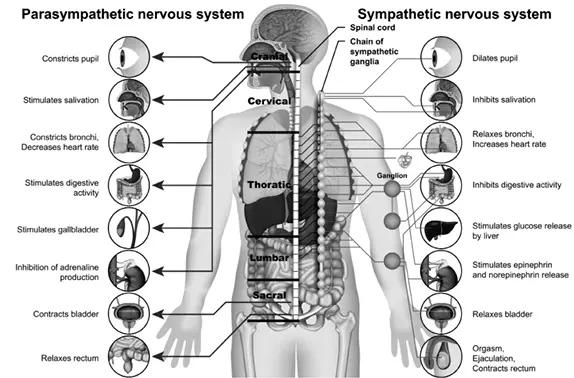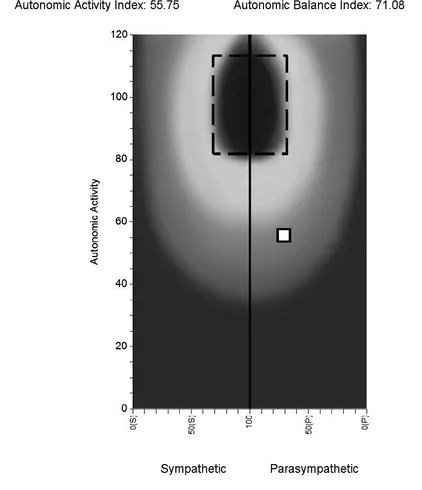Typical emotional stressors include relationship problems, financial worries, harassment at work, etc. Chemical stress refers to medications, pesticides, poor diet, mineral deficiencies, pollution etc. Physical stress pertains primarily to spinal misalignments that appear to deviate from the norm on an X-ray, but are not considered to be a medical problem by the medical community. A holistic therapy should always aim to find out what kind of stress is involved and to reduce it (or all of them). Changes in blood pressure, cholesterol, blood sugar, thyroid levels, sleep, etc., will then return to the physiological norm and often make pharmaceutical treatment unnecessary.
The parasympathetic nerve is the counterpart that reduces heartbeat, regulates sleep, lowers blood pressure, strengthens thyroid activity, stimulates digestion and induces tissue healing. At the upper cervical medulla, below the cranial dome, is the nucleus of the so-called “vagus nerve,” one of the most important parasympathetic nerves. This nerve is responsible for a multitude of functions, including nerve supply to the bronchi, lungs, heart, esophagus, stomach, intestines for muscular contraction, but also, and even as a primary function, transmits sensory impulses from the intestines and the other internal organs to the brain. It can be restricted or irritated in its function by subluxations or malpositions of the upper cervical spine or the skull itself. Furthermore, a large parasympathetic nerve plexus lies in front of the coccyx on the pelvis, whose functions can be impaired or irritated due to malpositions of the pelvis, after accidents or after birth and can lead to sleep disorders, digestive problems, mood swings and increased susceptibility to infections.
This means that any impact on the spine can also have an influence on organs, muscles, joints, fascia and endocrine glands. Accidents or other external trauma, as well as mineral deficiencies with subsequent degeneration of disc material, will have adverse structural consequences on the functioning of the spine and the nervous system contained therein. Given that emotions are expressions of various biochemical processes, they are also influenced.

Source: Adobe Stock (bilderzwerg)
Without going into details here, it is important to understand that sympathetic and parasympathetic nervous systems must maintain a balance. At times, one may be more dominant than the other—this way, the metabolism is adapted to the environment and regulated. However, when a persisting imbalance prevents the metabolism from adapting, symptoms develop and may vary depending on the spinal configuration. From this point of view, high blood pressure is therefore not a disease, but an adaptation of the autonomic nervous system to an existing stress factor. The same reasoning can be applied to other chronic diseases (see from A-Z) (1). To further emphasize this, the autonomic nervous system can be illustrated, and then through images depicting it before/after a course of treatment, shown how autonomic function (and thus health!) has improved.
Using a heart rate variability measurement, it is possible to visualize the autonomic nervous system. This principle is based on the fact that the heart beats at a certain frequency. The distance between two beats is almost equal at rest, but not exactly. The differences in the intervals between heartbeats is called heart rate variability. How variable this interval is depends on the activity of the autonomic nervous system, which stems from nerves in the upper cervical and upper thoracic spine.


Source: Dr. Matthias Meier
The upper figure on p. 30 shows a patient who is in a state of sympathetic dominance (white dot). Some stress factor (physical, chemical or physiological) causes the body to respond with a stress reaction. Her symptomatology included digestive problems, recurring skin problems, difficulty concentrating and pain in her spine with bouts of dizziness. The lower figure on p. 30 shows a patient who has been exposed to combined stress for decades and in whom the typical stress reaction has degenerated into a burn-out situation, and thus into a deeply parasympathetic state. His clinical history includes constant fatigue, night sweats, lack of motivation and several past cardiac events. Both patients are experiencing abnormally low levels of autonomic nervous system activity and as a result do not have optimal sleep or optimal healing ability. The goal is to bring both patients into the green zone (dashed zone in the middle).
Not only is balance restored, but the activity of the nervous system can be positively influenced, which in turn has a variety of effects—energy levels increase during the day, sleep becomes more restful, symptomatology decreases, medication can be reduced, pain disappears, and the immune system becomes stronger. A key component of this is being able to sleep well and restfully throughout the night without having to get up or wake up. Healing happens while sleeping, particularly during the deep sleep phases. Therefore, one of the goals of therapy must always be to improve sleep quality and to avoid or at least reduce nocturnal disturbances in order to have the greatest possible effect on health. There is some evidence that impaired function or a lack of balance is a driving factor of many chronic diseases, and measuring it can provide some indication as to the patient’s current state of stress.
The spine functions as a sheath and support for the nervous system and is essential for function and balance. Normally, the spine is straight when viewed from the front and has a double S-curve shape when viewed from the side.


Source: Adobe Stock (SciePro)
Although this structure is considered physiological, it can be influenced by many factors—accidents or other external forces, chronic mineral deficiencies, chronic poor posture and so on. All these factors have an impact on the structure of the spine, and consequently, the function of the nervous system it contains, in the short, medium, and long term.
Where it gets interesting is when the poor posture/structural problems are improved. This has a strong influence on the autonomic control of peripheral tissues and thus can have a positive effect on virtually all chronic diseases. This highlights how powerful our central nervous system is and how hard it tries to function for us. It is for this reason that knee pain resolves when the biomechanical burden of the spine is improved, even though the knee was never touched. This principle is applicable to all tissues, since the nerves from the spine reach and influence all cells of the human body. If you have an army that is losing a battle, you don’t replace a single soldier (that only happens in Hollywood movies), but rather you have the general issue different orders so that the entire army acts in a different way. Perhaps you can envision something similar for the functioning of the nervous system.
Читать дальше

















